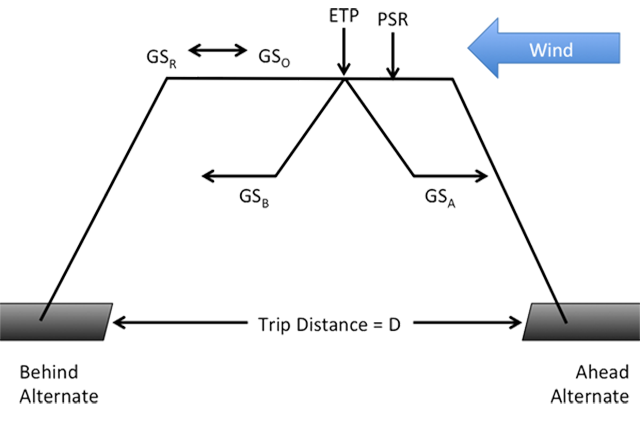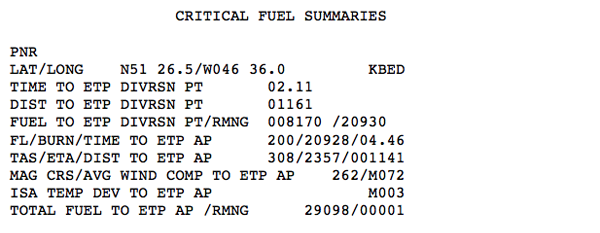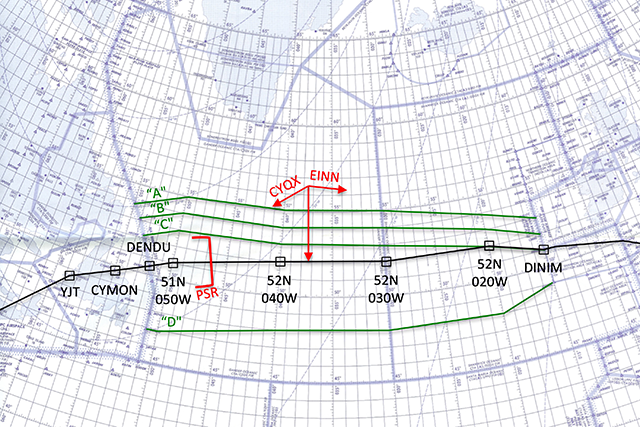The Point of Safe Return (PSR) provides the pilot with the farthest point to which the aircraft can go and be able to return safely to the departure point with adequate holding, approach, landing, and alternate fuel. It is normally used when flying to remote island destinations with no diversion possibilities en route but can be useful even when alternates are available.
— James Albright

Updated:
2014-02-02
Some call the point where you can reverse course and make it back to your departure airport the "Point of No Return." I think if you do that, you should have the sound track to "The High and the Mighty" cued up and whenever anybody says "point of no return," there should be dramatic music playing. I prefer to call it the "Point of Safe Return."
The Point of Safe Return is seldom discussed because it is rarely critical with modern aircraft designed for oceanic travel. About the only time I've ever used it was during combat operations to Bosnia and even then it was academic; we always had enough fuel to get to Sarajevo, reject the landing, and come home. But even without the threat of a AAA battery, the PSR can be of use to you.

1
Regulatory requirement
There is no regulatory requirement to compute a Point of No (or Safe) Return. In fact, the only regulatory mention is for 14 CFR 121 and even that is less than definitive:
- No certificate holder may operate an airplane outside the 48 contiguous States and the District of Columbia, when its position cannot be reliably fixed for a period of more than 1 hour, without—
- A flight crewmember who holds a current flight navigator certificate; or
- Specialized means of navigation approved in accordance with §121.355 which enables a reliable determination to be made of the position of the airplane by each pilot seated at his duty station.
- Notwithstanding paragraph (a) of this section, the Administrator may also require a flight navigator or special navigation equipment, or both, when specialized means of navigation are necessary for 1 hour or less. In making this determination, the Administrator considers—
- The speed of the airplane;
- Normal weather conditions en route;
- Extent of air traffic control;
- Traffic congestion;
- Area of navigational radio coverage at destination;
- Fuel requirements;
- Fuel available for return to point of departure or alternates;
- Predication of flight upon operation beyond the point of no return; and
- Any other factors he determines are relevant in the interest of safety.
- Operations where a flight navigator or special navigation equipment, or both, are required are specified in the operations specifications of the air carrier or commercial operator.
Source: 14 CFR 121, §121.389
2
The math
The following formula is used to calculate the ground distance from the departure airport to the Point of Safe Return:
Where:
Endurance = Total Fuel Quantity / Average Fuel Flow
GSO = Normal Outbound Ground Speed at Cruise Altitude
GSR1 = Return Ground Speed at Normal Cruise Altitude
Source: G450 Performance Handbook, page PB-23.
A few notes:
- Unlike the ETP, the Point of Safe Return should be based on your original departure airport, since that is where you are likely to want to go if it becomes an issue. (More on that below.)
- The terms GSR, GSC, and ETP are for the "Equal Time Point."
More about that: Equal Time Points.
3
Example PSR
The example flight used in International Operations Manual / Oceanic Departure is from KBED to LSGG on a G450 which has more than ample range. The flight planning service automatically computed a "PNR" which came to 1,161 nm from KBED. Note that this flight planner uses the "PNR" nomenclature. They provided a latitude / longitude so we plotted that:
If any of our passengers, for some reason, decide they need to go back to our departure airport (KBED), the last moment you can do this without having to make a fuel stop is shown with the red bracket on the chart. Keep in mind that if you return at this point, you will need to fly direct to the airport, the PSR does not use normal routings that anyone less than an emergency aircraft will be offered.
References
(Source material)
14 CFR 121, Title 14: Aeronautics and Space, Operating Requirements: Domestic, Flag, and Supplemental Operations, Federal Aviation Administration, Department of Transportation
Gulfstream G450 Performance Handbook, GAC-AC-G450-OPS-0003, Revision 20, November 30, 2011
Please note: Gulfstream Aerospace Corporation has no affiliation or connection whatsoever with this website, and Gulfstream does not review, endorse, or approve any of the content included on the site. As a result, Gulfstream is not responsible or liable for your use of any materials or information obtained from this site.


